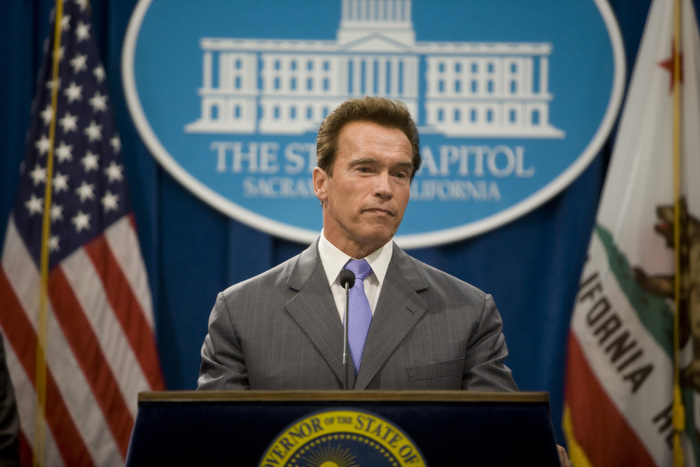A False Fix for the Mortgage Crisis
Freezing foreclosures has become a favorite tactic to slow the housing meltdown -- a way to show that something’s being done to help people stay in their homes. But there’s no solid evidence these reprieves do anything more than postpone the day of reckoning.
Jul 31, 2020367.8K Shares5.1M Views
Gov. Arnold Schwarzenegger (gov.ca.gov)
As the government, housing advocates and banks like Citigroup and JPMorgan Chase struggle to streamline loan modifications and stave off foreclosures, one tactic keeps coming back to life as a sure-fire weapon: the 90-day mortgage moratorium.
In California, Gov. Arnold Schwarzenegger recently calledfor the reprieve as part of a new economic stimulus package. Democrats, who are in control of the state assembly, respondedTuesday by going even further, proposing a 120-day moratorium.
Illustration by: Matt Mahurin
The moves follow the 90-day moratorium put forwardby President-elect Barack Obama in October. And Obama’s call, in turn, mirrored one madeby his Democratic primary opponent, Sen. Hillary Rodham Clinton (D-N.Y.), last December.
Obama opposed a moratorium when Clinton first proposed it. But calls for a moratorium on foreclosure have become a trend as the mortgage crisis continues to worsen. Freezing foreclosures, even if temporary, is a way to show that something’s being done to help people stay in their homes — though there’s no solid evidence that moratoriums alone do much more than put off a foreclosure for a few months.
The reasons are clear. Moratoriums can’t straighten out the situation that got a homeowner in trouble in the first place. They can’t suddenly allow someone to afford a house that’s too expensive. They can’t undo a loan made under deceptive and misleading terms. But the idea keeps coming back during difficult financial times, a sign of the desperation in finding a lifeline for homeowners and halting the steady pace of foreclosure filings.
“There’s nothing magical about 90 days,” said Michael Collins, founder of the PolicyLab Consulting Groupin Ithaca, N.Y., a mortgage research firm. “If you couldn’t afford your loan three months ago, you still can’t afford the loan 90 days later.”
Moratoriums on a large scale began in July, when the Federal Deposit Insurance Corp. took over the failed subprime lender IndyMac and frozeforeclosures to work out loan modifications. In September, after the federal government seized control of Fannie Mae and Freddie Mac, four Democratic senators calledon the agencies to adopt a similar freeze. Attorneys general from 11 states are also pushing lenders to adopt moratoriums.
Major lenders with troubled loans, including Bank of America, JPMorgan Chase and Citigroup, have recently announcedvoluntary foreclosure moratoriums while loan modifications are underway. States continue pushing for moratoriums modeled after Massachusetts’90-day freeze over the summer.
Just this month, Maryland createda 60-day cooling-off period that stops foreclosures while servicers try to do loan workouts. Maryland previously extended its foreclosure timetable from 15 to 150 days — a de facto moratorium.
But as the various moratoriums grow in popularity, so do questions about whether they are really worth it. The effectiveness of recent moratoriums hasn’t been studied at length, and they never worked all that well the last time they were tried in a systematic way — during the Great Depression.
Keeping someone in a home a little longer may be a noble goal, but it doesn’t address the underlying problems that led to a loan default. With loan modifications takingso much time, the 90-day period, or any other temporary hold, often doesn’t allow enough of a window to work something out — especially for a borrower in over his head. That leaves moratoriums as a way to look like something’s being done about the mortgage crisis, when, for many homeowners, it won’t make much of a difference.
In Massachusetts, for example, foreclosures declined in the three months following the state’s freeze in May. But after the freeze ended, foreclosure filings jumped 465 percent between August and September, RealtyTrac reported.With the freeze lifted, foreclosure filings were occurring at the same pace they had been before the moratorium.
Collins of PolicyLab said the continued push for moratoriums show how hard it is to deal with a crisis that involves different foreclosure problems in different parts of the country. Homes go into foreclosure in California, Nevada or Florida usually because of inflatedhome prices; in Cleveland, homeowners often lose their properties due to deceptive subprimeloans.
The problem with putting holds on foreclosures is that, with the exception of a successful new program in Philadelphia, the delay usually doesn’t buy enough time to modify the loan or even to work out the problems that got the borrower into trouble.
“Everybody wants to do a one-size fits all approach,” Collins said. “But there isn’t just one solution.”
Establishing a moratorium is easier, in many ways, than separating the borrowers who really need help from the ones who don’t, he said. Servicers were never set up to do high-volume loan modifications. Some can’t be done at all. Moratoriums, by contrast, aren’t difficult to impose quickly, and they slow down foreclosures.
Some moratoriums work better than others.
Since June, the city of Philadelphia has put a hold on sheriff’s sales until borrowers and lenders take part in face-to-face, court-ordered mediation. The program has been hailed as a national model,preventing foreclosures because it requires both sides to have contact with each other.
The problem is that this can’t always take place before a foreclosure. Many mortgage loans have been packaged and sold in pieces to investors around the globe. Borrowers often can’t figure out who the mortgage servicer is, much less how to contact them.
In its first three months, the program avertedthe sale of nearly 80 percent of the 552 properties referred to it. Other cities, including Pittsburgh and Cleveland, are looking to emulate it.
“The Philadelphia program is the best model I know of,” said Alan White,a Valparaiso University law professor who studies loan modifications. “It requires servicers and homeowners to work with a mediator and the mediator has the power to request continued foreclosure postponements from the court, so long as a workout seems possible.”
In his view, it’s not that foreclosure freezes are a bad idea. It’s just that they’re often not put together effectively.
A well-designed foreclosure freeze wouldn’t have a mandatory time limit like 90 days, White suggested, as long as the homeowner and lender were working in good faith toward a modification. In some cases, borrowers could make interim payments. The freeze might also allow lenders to move immediately on vacant and investor-owned properties, White said.
Done correctly, a freeze would allow a window for a loan workout. Or at least an attempt at one.
“The point of freezes and moratoriums is to allow homeowners and mortgage servicers more time to negotiate more workouts,” White said. “The servicers are overwhelmed and understaffed, and it is clear from surveys of housing counselors that some foreclosures are proceeding against homeowners who are willing and able to pay.”
One way to encourage more freezes might be to set up a fund into which homeowners pay 25 percent of their gross income each month until the moratorium ends, said Rob Strupp, directorof research and policy with the Community Law Center in Baltimore, which provides legal services to grass-roots groups.
This takes care of the problem of freezes being perceived as an unfair break for homeowners who aren’t paying their mortgages. And freezes should last at least six months or so, Strupp said. “The freeze is not the solution,” Strupp said. “The freeze is the time you need to come up with some sort of solution.”
To Alex Pollock,a former bank executive who is now a senior fellow at the American Enterprise Institute specializing in housing and finance, foreclosure freezes haven’t shown themselves to be much of a success since they first were called for in 1890. Populists of the day, like Mary Elizabeth Lease,railed against foreclosures on high-interest-rate loans to Kansas farmers.
Foreclosure moratoriums were also in vogue in the 1930s. They didn’t do much to relieve the problems then. “I find it hard to believe they have any long-term effect,” Pollock said.
PolicyLab’s Collins said it may be that given the scope of the mortgage crisis, foreclosure freezes need to be combined with other kinds of help. In his blog, Collins writes, “states with high foreclosure rates which offer media campaigns, refinance pools grants and other initiatives combined with lender offers of default counseling may prove most successful” in bringing down foreclosures.
In September, RealtyTrac foundthat foreclosure filings overall fell by 12 percent, compared to August. It attributed the drop to changes in state laws in California and North Carolina that required lenders to contact borrowers 30 to 45 days before filing a default notice. Those laws, at least temporarily, delayed the foreclosure process, giving hope to the moratorium idea.
But with 6.5 millionforeclosures projected over the next few years, the search remains for something far more permanent than a 90-day reprieve.

Paolo Reyna
Reviewer
Paolo Reyna is a writer and storyteller with a wide range of interests. He graduated from New York University with a Bachelor of Arts in Journalism and Media Studies.
Paolo enjoys writing about celebrity culture, gaming, visual arts, and events. He has a keen eye for trends in popular culture and an enthusiasm for exploring new ideas. Paolo's writing aims to inform and entertain while providing fresh perspectives on the topics that interest him most.
In his free time, he loves to travel, watch films, read books, and socialize with friends.
Latest Articles
Popular Articles

